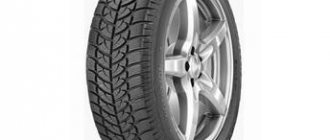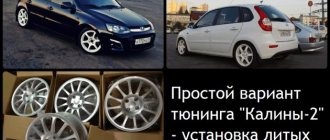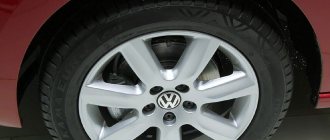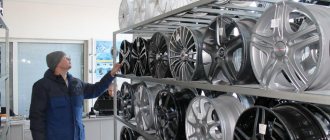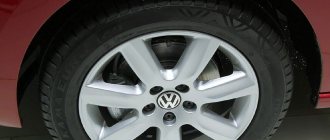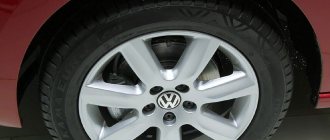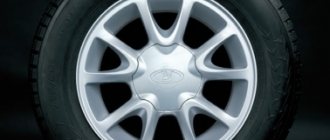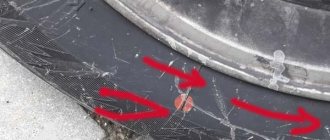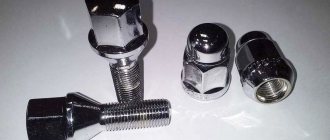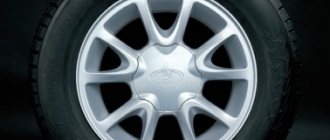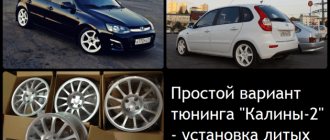16.09.2019
| (Votes: 5, Rating: 4.8) |
Issues discussed in the material:
- How tires are classified according to design parameters
- What is the classification of summer tires?
- How are winter tires classified?
- What is the classification of all-season tires
Sooner or later, any car owner faces the task of replacing worn-out tires with new ones, or changing summer tires for winter ones. However, it is not always possible to find exactly the same ones as they were, from the same manufacturer and with the same parameters. In order to make the right choice yourself, you need to have an idea of what classification of tires there are, as well as understand what the markings on them mean. Otherwise, you can buy completely unsuitable specimens, throwing money down the drain. Moreover, traveling in a car in this case will become very unsafe.
Classification of tires by design parameters
The manufacturer places all the necessary information about the classification of protectors directly on them, on the side. Without sufficient experience, you may not understand how tires of different classifications and markings differ. They all look the same, and the choice is very large. How to correctly choose exactly what is best suited for your car and will last a long time? What indicators are of paramount importance?
To indicate the classification of automobile rubber, manufacturers use letters and numbers that are printed on the side surface of the slope and carry information about permissible loads, speed, temperature resistance, traction and other characteristics. At the moment, by the way, they have become somewhat more complicated than before. Moreover, some of the data can be indicated on the outer side, and some on the inner side.
The classification and markings on tires manufactured in Europe and America (US Department of Transportation, DOT) are not the same. So keep in mind that some examples will have US markings, others will have European markings, and those made in Japan will have key characteristics listed completely differently.
Any car protector is a structure consisting of the following components:
- Frame, or so-called cord . It is made from natural or artificial very strong threads, less often - it can be wire (made of thin steel). This is a structural element hidden in the thickness of the tread rubber and bearing the load.
- The working surface is in the form of a relief tread . This is the outer part that touches the road while driving. The classification of wheels and tires includes information about the height, type of rubber, and the wear of the tread shows how worn it is. For the warm and cold seasons, different tire patterns are provided, as well as the composition of the rubber used in production.
- A special breaker made of steel wire (located directly inside the rubber), the purpose of which is to protect the frame from damage and strong impacts when it comes into contact with uneven surfaces on the road.
- Board . This is the edge of the tire that sits directly against the rim. It is specially made thicker, with a rigid steel wire inside, which allows the rubber to hold firmly on the wheel.
- The side part that “works” as a damper . It lies between the side and the working surface, and springs when moving under the weight of the car.
The classification of car tires differs depending on the characteristics of their structural components.
There may be a different structure of the frame (cord). Based on this parameter, a distinction is made between radial tires and diagonal tires (a rather rare option). Radial ones are marked with the letter R, they are more popular because they last longer. The structural difference between radial and diagonal treads is that in the first, the reinforcing frame fibers are located in the direction of the wheel radius, and in the second, diagonally to it.
The classification of tires depending on their purpose, that is, based on their performance characteristics, also varies.
Summer ones, also called road ones. For their manufacture, a rubber composition is used, which becomes slightly elastic at low temperatures. This increases braking distance and reduces car controllability. Therefore, summer tires are suitable for high-speed driving, however, only when the temperature outside is above zero.
Winter tires are made from a material with a different composition, and the tread is made higher. It turns out to be quite noisy and is not suitable for summer driving.
We recommend
“Which tire size is best: for summer, winter, off-road” More details
There are also all-season treads that you can ride on all year round. However, it should be understood that their characteristics will not be the highest. In severe frosts or heat, they can fail and make movement unsafe, although you will, of course, save money.
As for the classification of off-road tires, universal tires that are close in their characteristics to all-season tires are best suited for driving both on asphalt and dirt roads.
If you drive a lot on muddy, rocky dirt and embankment roads, then your wheels should have the highest cross-country classification. Keep in mind that on a flat asphalt surface they are very noisy, the car becomes more difficult to control, and more fuel is consumed when driving.
Tires come with different tread patterns, and taking this into account, there is a classification of tires according to their intended purpose. There are three design options:
- a simple pattern, without a clearly defined direction, which is typical for most existing slopes.
- a relief directional pattern used for summer tires, which promotes water drainage;
- an asymmetrical pattern, when the middle of the slope is made with a non-directional pattern, and the relief of the edges is clearly drawn in one direction, again, to drain water.
Sealing
Based on the sealing method, tires are divided into tubed and tubeless. It is very easy to determine which tire you have in front of your eyes - just look at the markings that the manufacturer has installed on the product: TT - tube version and TL - tubeless. Let's start with the type of tires that appeared earlier than others - consider the option of tires with a tube.
Tube tires
This type of tire appeared quite early in the history of the automotive industry. This option replaced a very inconvenient type of balloon tire, which was based on a tube with a thick rubber edging. A tube tire consists of a tube, a tire and a valve for inflation.
At the moment, tube tires are in less demand, since if this type of rubber is punctured on the road, the car will not be able to continue moving. The characteristic of the tire is such that the air will quickly escape from such a chamber, and this will lead to a complete deflation of the wheel.
Tubeless tires
The design of a tubeless tire allows for additional strength of the product. The characteristics of rubber include a durable sealing layer reaching a thickness of 2 mm. Tubeless tires are filled with air mass through a valve not inside it (as in the tube version), but in the passage of the wheel frame.
This tire option guarantees that you can travel several kilometers to the service station in case of a puncture. These tires provide maximum safety while driving. But the tubeless version is significantly more expensive than samples with a camera.
Classification and selection of summer tires
An important indicator in the classification of tires is the composition of the rubber from which they are made. Their performance indicators, including seasonality, depend on this. Inexperienced car owners tend to believe that it is not necessary to change winter tires to summer tires after the cold weather ends, and this is a big misconception.
To make summer skates, heat-resistant materials are used that can also withstand high-speed driving. Such protectors practically “go stiff” at low temperatures, and driving on them becomes dangerous due to poor grip on the road.
A special pattern is made on summer tires; in addition, it is shallower in depth than on winter tires.
It is possible to give preference to all-season tires only in regions where the difference between winter and summer weather is insignificant. Such tires behave normally both in hot and colder temperatures.
Be sure to take into account the weather conditions in your area of residence when choosing summer tires for your car.
- Tire size classification
One of the important design features of automobile protectors is their size. When buying summer tires, it is important to be able to choose the right parameters that are suitable specifically for your car. Where can I find the necessary information? Either on a special plate (on the front side of the door or on the gas tank hatch), or in the documents for the car. You can simply go on the Internet to the page of the manufacturer of your car and read the necessary information there.What is meant by the term standard size? It includes the following geometric parameters: tread size in height and width, as well as the landing diameter. Plus, you should definitely pay attention to the country of the manufacturer, suitability for a particular season, speed limit, permissible loads, etc. All these are very important parameters in the classification of car tires, for which there are special designations.
You cannot install tires of the wrong size on your car if you do not want to encounter complications.
A slope that is too large will certainly catch the wheel arch when driving on an uneven road with potholes, or when turning.
If the size is lower than required, this greatly affects the service life of the suspension (it is reduced by half, or even more), in addition, the car becomes more rigid.
Low profile tires, however, are good because they make the car more manageable and controllable, they make turning easier, etc. It may make sense to buy just such treads, but take into account your most frequent routes and the quality of the road surface on them.
When studying the classification of tires and selecting them for the summer, keep in mind that it is better to give preference to wide models. This gives a larger contact surface between the wheel and the road, and, consequently, better vehicle stability and high dynamic performance. At the same time, the braking distance is greatly reduced and acceleration time is reduced. The negative aspects when driving on wide tires are the so-called aquaplaning effect, which occurs if the car is not moving too fast, as well as the consumption of more fuel.
- Classification of tires by tread pattern
The pattern on the tire is also of no small importance, along with the size and material from which it is made.For example, there are tires with a directional V-shaped pattern. What does this do? Better car handling, later occurrence of the aquaplaning effect, and overall driving comfort. The main purpose of a pattern of this shape on the surface of the wheel is to quickly drain water flows. This property is especially important if you live in an area with a lot of rainfall. Important! It is allowed to swap wheels with such tires only on one side of the car.
The greatest demand is for slopes that have a symmetrical, that is, non-directional pattern on the surface. Firstly, because they are relatively cheap. And secondly, they have a number of advantages: they do not cause aquaplaning, provide good car handling and generally provide a comfortable feeling when driving. When it comes to classifying tires based on speed, tires with a non-directional pattern are best for those who do not like to drive fast. Important! Wheels with such treads can be swapped as desired.
As for tires with an asymmetric pattern, they respond well to seasonal temperature changes and uneven roads, that is, they have the same properties as all-season tires. The reinforced side zones of the treadmill give the machine better stability on turns.
Smaller blocks run along the inner area of the treadmill, which provides good water drainage and, consequently, better adhesion of the wheel to the track surface. To increase directional stability, a special rib runs along the middle of the tire.
The running parameters of ramps with an asymmetrical pattern are quite high. Important! It is allowed to swap such wheels only on one side of the car.
We recommend
“Which wheel size is best, and is there a “golden mean”? » More details
- Classification of tires by noise
The blocks that make up the tread pattern directly affect the noise level created by the wheel when driving. Of course, you want the noise level to be minimal, however, it is impossible to understand by visual inspection whether the selected tire will be noisy. If this is very important to you, try to collect information from experienced car owners, via the Internet, or by asking a sales consultant for help. - Some important tips
Having selected for yourself tires of a suitable classification by speed, load, pattern, etc., do not neglect the recommendations of those who have more experience and are better versed in the issue.Check out the test results online, go to the car enthusiasts forum and ask questions, read reviews. Perhaps this will help you adjust your choice.
If your driving route often runs through rough terrain or bumpy roads, then tires with reinforced sidewalls are better suited for you. They are very resistant to sharp protrusions and noticeable impacts on holes and potholes.
In addition, fuel consumption is significantly reduced if you have to travel long distances every day.
And one more piece of advice: when choosing tires of a suitable classification, give preference to products from reputable brands. This will cost a little more, but during operation you will understand that you have purchased high-quality, reliable tires that will last faithfully and for a long time.
Wheel profiles
About the design and operation of a car How to inflate a car wheel with a compressor. How to inflate tires correctly
For the rational interaction of wheels and the rail track, the shape of the rolling surface – the wheel profile – is important. On (Fig.
5, a) shows the standard tread surface profile that the wheel has after turning. This profile is characterized by a ridge height of 28 mm and a thickness of 33 mm measured at a distance of 18 mm from the apex, a conical tread with tapers of 1:10 and 1:3.5 and a chamfer of 6 x 6 mm.
Rice. 5 – Rolling surface profiles: a – standard; b – recommended by VNIIZhT
The ridge, which protects the wheelset from derailment, has an inclination angle of the outer edge of 60°. The conical surface, in contrast to the cylindrical one, prevents the formation of wear (rolling) that is uneven across the width of the wheel, facilitates the passage of curves and centers the wheel pair in straight sections of the track. However, due to the conical shape of the rolling surface, a tortuous movement of the wheelset appears, which is studied in the course “Wagon Dynamics”. With the surface located at the outer vertical edge, the wheel less often rests on the rail, so it wears out less than the main contact surface. Due to the presence of a 1:3.5 taper and a chamfer, the outer edge of the wheel is raised above the rail head, which facilitates the passage of turnouts in the presence of rolled metal or an influx of metal on the wheel.
Since the wheel has a conical surface, its diameter, rolled size and rim thickness are measured in a certain plane - along a rolling circle located at a distance of 70 mm from the inner edge of the wheel. The distance between the rolling circles of wheels on broad gauge railway cars is 1580 mm with a nominal size of 1440 mm.
VNIIZhT proposed a new profile of a car wheel (Fig. 5, b). Experiments have shown that wheels with this profile have 1.2–1.3 times less flange wear. Increasing the angle of inclination of the outer edge of the ridge to 65° increases traffic safety (stability of the wheelset on the rails). For example, when traveling at a speed of 55 m/s (200 km/h), the safety factor against derailment increases by 30%.
A similar wheel profile has been introduced in a number of European countries. In this case, the angle of inclination of the outer edge of the ridge is increased to 70°. According to research by the International Union of Railways, thanks to the use of a new profile, wheel wear is reduced by 30%, the likelihood of derailment is reduced (at high speeds by 1.5 times), and the smoothness of the ride is improved. According to British researchers, the mileage of wheelsets without turning the rolling surface increases by 50% compared to wheels of the previous profile.
Improving the smoothness of the ride by reducing the frequency of wobble oscillations, especially significant at high speeds, is also achieved by replacing the 1:10 taper with a 1:20 taper. Wheels with this taper are used for high-speed carriages in Japan and in a number of other countries, and in France and Switzerland for all passenger carriages. The wheels of some railway cars in our country have a taper of 1:20, which are subject to increased requirements for smooth running.
The transition to a new wheel profile is associated with the need to modernize wheel lathes and measuring instruments. In addition, when turning worn wheels, you may have to remove thick chips. Research to improve the wheel profile continues.
How are all-season tires marked?
At first glance, deciphering the existing markings in the classification of all-season tires may seem like a rather difficult task, however, the point is that different manufacturers label almost the same information differently. Markings can be like this:
AS – All Season;
All Weather;
R+W – Road+Winter;
AW – Any Weather;
AGT – All Grip Traction;
M+S – Mud+Snow (mud + snow).
In addition, the all-season tread may have a “Snowflake” and “Sun” icon. Of course, you can become confused by so much symbolism and get confused when choosing tires.
But in reality, all of the above classifications and markings are used to designate treads suitable for driving in all weather conditions.
- Advantages of all-season tires
First of all, it is worth mentioning their versatility. Unlike tires designed exclusively for winter or summer, models of this classification are suitable for any weather.In addition, this is a profitable option in terms of money and time. If you don’t buy tires for winter and summer separately, you will save about 10 thousand rubles. on one set. Plus, consider the cost of visiting a tire workshop once every six months, at least a thousand rubles.
By choosing all-season tires from the existing tire classifications, you can count on comfortable and soft movement in your car, even if the trip is a long distance. This is ensured by the softness of all-season wheels compared to summer options.
Winter driving on all-season tires is relatively quiet because they do not have studs, which create excessive noise.
Practice shows that using summer or winter treads “out of season” leads to their wear out too quickly. But the same cannot be said about all-season tires; they are designed in such a way that they can withstand any weather conditions.
Along with a number of advantages in using tires of this classification, there are also weaknesses.
- Disadvantages of all-season tires
This type of protector has average technical characteristics that cannot guarantee one hundred percent control over the car at extreme subzero temperatures, or vice versa, in extreme heat. And these are exactly the weather conditions that exist in most regions of Russia.When it is too hot outside, such rubber softens too much, and on a wet roadway it does not provide sufficient grip on the road surface. In cold weather, on the contrary, it becomes too hard. The result is a more than doubling of the braking distance.
A car that drives on too soft tires (in hot weather) consumes more fuel.
All-season slopes are also not very suitable for driving on snow; for this they are too narrow and can simply slip.
At the same time, both passenger and truck tires of the all-season classification are more expensive than summer treads of the same size.
We recommend
“How to check tire wear: a few simple methods” Read more
In general, it turns out that all-season tires have special characteristics and are suitable for use only in mild climates, without too low (or high) temperatures, snowy winters, etc. You won't be able to drive them at high speed. These are tires for everyday quiet driving over short distances, for example, to work, to school, to home, etc.All-season tires are good because they do not need to be changed twice a year, as do car owners who use winter and summer tires.
Purpose of tires by type of road surface
Based on the road surface, tires are divided into:
Often, road and winter ones are classified as the same type, but we will look at them separately. Technically they are somewhat different.
Road tires usually have a classic tread and are designed for road use. All the main differences between tires of this type are the features of the tread, as well as the ability to maintain control over the car on wet asphalt. They are distinguished by a straight pattern with virtually no lamellas.
Off-road vehicles are designed for use on any surface. Thanks to the large tread, sipes and other features, such tires allow you to drive effectively on any surface without fear of problems.
Universal tires combine the qualities of road and off-road tires. But, according to many experts, they are inferior to specialized tires.
If you drive most of the time in the city and on country roads, it is better to take regular road tires
Winter tire classification
There are two types of tires designed for driving in the cold season: European and so-called Scandinavian (the same northern, or arctic). What are their main characteristics?
Scandinavian type protectors. Their design is a grid of clear rectangles arranged in a checkerboard pattern. This is a rather aggressive type of wheels, just the kind you need for winter. A car on such tires can easily overcome snowy and icy roads; the crust easily flies off them without interfering with reliable traction. Tires of this speed and load classification are best suited for country trips, or if you constantly live in rural areas.
Tires belonging to the European type classification are distinguished by a clearly defined diagonally directed pattern. Moreover, the pattern contains many slots and grooves, thanks to which the grip on the road is significantly improved, the wheel practically sticks to the road. This type of tire is good for driving around the city, especially in wet weather during the cold season.
There are four types of coverage:
- Snezhnoye.
- Ice.
- The asphalt is dry.
- The asphalt is wet.
In general, studded and “sticky” treads, regardless of the manufacturer, feel differently on different surfaces.
- On a snowy road
It is a misconception to think that it is better to drive in the snow with treads with spikes than with so-called Velcro. Indicators of repeated tests and measurements indicate that both tires show the same results.In addition, there is an opinion that at very low temperatures it is preferable to put Velcro on the car, because the spikes do not pierce frozen snow.
- On an icy track
If we consider from the point of view of behavior during braking, then tires of different classifications (meaning both Velcro and studded) behave the same. But acceleration on spikes gives the car one and a half, or even two times faster. Therefore, on friction rubber you don’t have to worry about braking, even if the road is uphill or covered with ice. But acceleration will be more difficult.For severe frosts (below 23 degrees), professionals recommend treads with spikes. They provide better grip on the road surface throughout the entire driving process, that is, during acceleration, cornering and braking. It is also important that if the clutch suddenly falls off, the car remains under control if you are driving on tires with spikes.
As for tires classified as Velcro, while they are rolling (with the support of active ESP and ABS systems) they feel great on ice, but the car will immediately start to skid if the wheels slip. The conclusion is simple: if your car has ESP and ABS installed, you can safely drive with Velcro.
But keep in mind that if the car skids, it will be difficult to control and level it. But if your car is shod with studs, and there is a skid on the front-wheel drive, you should slightly “accelerate” and point the steering wheel in the right direction.
In general, we can say that in general studded tires provide better grip even at -20 Celsius.
We recommend
“How to choose tires for a crossover: tips, criteria, examples” More
Many people have a reasonable question: what is better to drive at minus five degrees? Again, the spikes win. Numerous tests show that during braking, studded protectors give a 20-25% better result, and are 100% ahead of Velcro protectors if the street is -1. This means that the braking distance with Velcro is twice as long as with studs if the road is covered with ice, but the top layer has melted and turned into water.When choosing tires from existing classifications, keep in mind that Velcro tires are good to drive at -20 degrees, but their overall grip on a crowded road is worse. And the spikes are universal and reliable at any temperature and on different types of ice.
What to ride is, of course, up to you to decide.
The only disadvantage of studded tires is noise on asphalt, especially if you choose a model with a lot of studs. Velcro makes less noise than summer ramps.
- On an asphalt road
During the braking process, studs and Velcro show approximately the same result. The decisive factor here is the composition of the rubber from which the tire is made and the model.If we talk about driving at high speeds, 100 km/h and above, then the studs, due to their good grip on the road, give the car greater stability, especially in corners. And this regardless of whether the track is wet or dry.
If you mainly drive around the city, where the asphalt is cleaned, not covered with ice, and depending on the weather, it can be only wet or dry, then it is better to put Velcro on your car. The spikes are really too noisy. But they do an excellent job on icy country roads.
So which tires are better to choose? For severe frosts (-20 degrees and below), Velcro is definitely more suitable. Thorns are preferable in slight frost, -5 degrees and warmer, down to zero.
What does a wheel consist of?
About sound insulation of car wheel arches
Components such as wheels are presented in the form of a high-strength and lightweight structure. Their movement is possible due to holding the frame in a vertical state during the rotational process. As a rule, a 2-wheeled vehicle is characterized by rear-wheel drive, in which the wheel at the rear of the device acts as a pusher, and the role of the weighty and controlling wheel is performed by the front wheel.
The main parts that make up a bicycle wheel are bushings, rims, tires and a tire.
The bushing consists of an axle, bearings and washers. The task of this part is to set and maintain the rotational state. Also, the rear wheel bushings are a place for attaching sprockets. If the bicycle is a road model, then a brake mechanism is installed inside the rear wheel hub.
The role of the rim, presented in the form of a round ring attached to the bushing, is aimed at making the wheels resistant to various impacts and loads.
The tire composition consists of tubes and tires. The appearance of the tube resembles a hollow rubber product, through the nipple of which air is pumped into the inner part of the tire element. The external component of a tire is the tire, which consists of beads, sidewalls and tread. The purpose of the bicycle is influenced by the type of tire used.
The reflector, presented in the form of an orange insert on the spokes, helps to make the wheels visible.
American designations: standard size
In the classification of American-made tires, there are two types of markings.
The classification of passenger and truck tires uses designations similar to European ones. The difference is that the letters “P” and “LT” are printed in front of the standard size, for passenger cars (Passanger) and light trucks (Light Truck), respectively. On the tread it may look like this: P 195/60 R 14, LT 235/75 R15.
There are other markings that have nothing in common with European ones.
For example, if in Europe it looks like this: 265/75R15, then the American analogue will be marked as follows: 31x10.5 R15.
31 is the length in inches of the outer diameter of the tire.
10.5 – tread width in inches.
R – marking indicating the type of structure, in this case radial. This is a relatively new model, it was preceded by diagonal ones.
15 – diameter along the inner circle of the tread, expressed in inches.
If you do not pay attention to inches (we are more familiar with centimeters), then the classifications and markings of tires adopted in the USA are clearer and more reasonable than those used in Europe (there is no exact value of the tread height, this indicator can be different, just like the width stingray). There are only three numbers here: the diameter along the outer circle of the tire, the width of the rubber and the diameter along the inner circle.
Non-flat tires
Puncture-free tires called Run Flat are very popular. In such products, manufacturers strengthen the sidewall of tires: they apply a special viscous substance to the inside of the tire, which seals the puncture hole while driving without reducing the pressure inside the tire. This technology makes it possible to travel about 150 kilometers at a speed of 80 km/hour without tire deformation. Many giant automobile factories make the basic equipment of well-known car models with puncture-free tires.
What do motorists think about the classification of car tires?
- How not to make a mistake when choosing winter tires? It is best to buy in the cold season. Just watch to see if the tire gets loose in the cold. If yes, then its quality leaves much to be desired. Good rubber should remain soft. Another point: there are no high-quality all-season tires. Accept it as a fact. Stock up on a summer and winter set, and put on your summer shoes no earlier than a stable temperature plus appears outside the window.
- Learn to understand a little about tire classifications and markings. The snowflake icon means that the tread has been tested for braking on a snowy hard road and with ABS in the car. The letters M+S (mud+snow) indicate that the wheels are suitable for snowy and very muddy roads. If there is no three-headed peak icon on the side of the slope, but only the letters M + S, this means that it is suitable for cold weather, although not for our harsh winters, but also for severe off-road conditions, muddy, icy roads, etc. .
- As for the classification of tires by speed and load, high indicators do not mean that the tread is more resistant to punctures or defects resulting from friction against curbs. High-speed protectors have a radial design, plus some options are supplemented with a special gasket (between the frame and the breaker). This makes them noisier, but also more rigid, which allows them to more reliably withstand impacts on the roads. If we talk about the classification of truck tires, then variants with a high index, in addition to additional padding, also have reinforcements in the side parts. The strongest ramps are produced for SUV-category cars; they also have reinforcing substrates placed in the shoulders. This makes them suitable for very bad roads, and if you have such trips ahead, then find an option that is suitable for your height and speed loads. It is worth mentioning that some foreign car manufacturers install ramps with greater load capacity on cars intended for Russian consumers. Such a car consumes more fuel and its wheels are heavier. The ride on them turns out to be quite harsh, which cannot but affect the level of comfort, as well as the wear of the suspension and body parts. Or you can simply pump up the wheels a little more than usual (0.3-0.5 bar more). But then the smoothness of movement and adhesion to the road surface will decrease.
- There are also colored stripes that can be applied on the outside of the wheel's tread, or in its groove. They relate only to the classification of tires according to their tread pattern (the size may vary). Such designations are used by manufacturers themselves or dealers for ease of storage in warehouses, so as not to create confusion and quickly find protectors with the desired pattern that are needed for sale and shipment. These colored stripes do not say anything about the quality of the tires, and in no case should their presence be considered a sign of a defect in the wheel.
Flat technology
Attempts to solve this problem led to the emergence of so-called “puncture-free” tires, also known as Run Flat tires.
There are two run flat technologies used on cars. The first of them is strengthening the sidewalls. Due to the increase in the rigidity of the sidewalls, when air is released, the weight of the car begins to be supported by the sidewalls. Thanks to this technology, a wheel without air can travel up to 100 km at a relatively good speed of up to 80 km/h.
Run flat technology
The second technology is the use of a support ring. This ring, made of high-strength plastic or metal, is installed and fixed on the rim inside the tire. In the event of a tire puncture, when the air is released, the wheel begins to rest on the ring, which allows you to continue driving without possible damage to the disc. Despite the fact that the ring is made of hard materials, the noise when driving does not increase much, since there is always a layer of rubber between the road and the ring.
Run flat technology really solves the problem of punctures. But in the case of wheels that have reinforced sidewalls, they will not help if the sidewall is severely cut. But wheels with a support ring are expensive and require specialized equipment for maintenance.
It is worth noting that Run Flat is a general designation for puncture-free tire technology. Manufacturers often use their own designation for such rubber, which creates some confusion.

